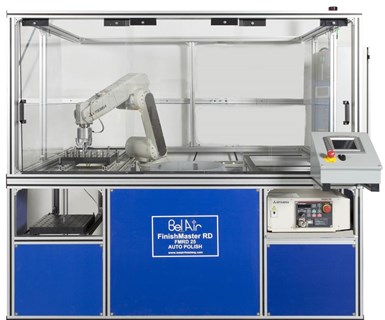Bel Air's AutoHone Uses Robot Arm to Insert, Remove, Clean and Dry Parts
Bel Air’s AutoHone reverse drag finisher rotates the media instead of the parts, which are then dipped into the flowing media in a rotating bin.
Share









Bel Air’s AutoHone reverse drag finisher rotates the media instead of the parts, which are then dipped into the flowing media in a rotating bin. The machine combines this method with robotic automation, enabling deburring, polishing, cleaning and drying. The machine is said to process parts in as little as 5 sec., making it useful for medical, automotive, aerospace, firearms, machined parts, and 3D printed parts finishing.
The robot arm enables five dimensional motions, meaning parts can be inserted into finishing media at angles tailored to achieving specific finishing specifications. Following the finishing process, the robotic arm cleans the part within the optional ultrasonic cleaning station and can also dry the part in the optional drying station before placing the part back into the tray.
Tool honing with the AutoHone reduces the friction of cutting tools by removing microscopic burrs and sharp edges increasing cutting speed and providing a surface to which coatings can adhere better, the company says. When pre-coated pieces are honed, the machine removes microscopic irregularities on the surface of the tool. These irregularities happen when the coating is unevenly distributed across the part’s surface.
Related Content
-
How to Accelerate Robotic Deburring & Automated Material Removal
Pairing automation with air-driven motors that push cutting tool speeds up to 65,000 RPM with no duty cycle can dramatically improve throughput and improve finishing.
-
Quick-Change Tool Heads Reduce Setup on Swiss-Type Turning Centers
This new quick-change tooling system enables shops to get more production from their Swiss turning centers through reduced tool setup time and matches the performance of a solid tool.
-
Selecting a Thread Mill That Matches Your Needs
Threading tools with the flexibility to thread a broad variety of holes provide the agility many shops need to stay competitive. They may be the only solution for many difficult materials.
































.png;maxWidth=300;quality=90)


